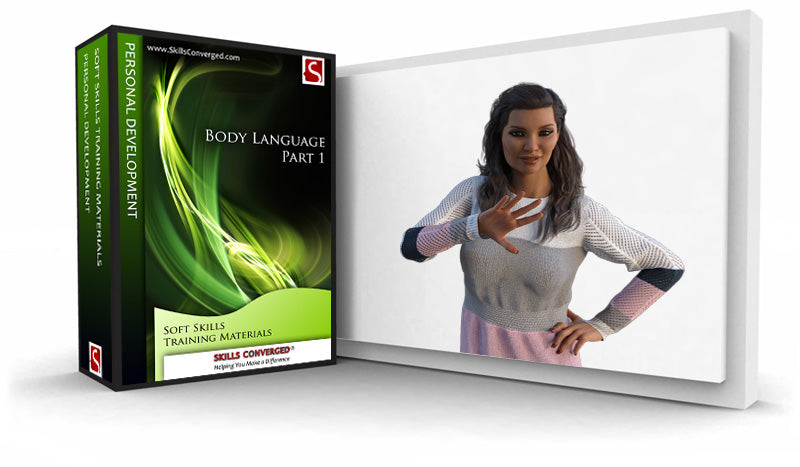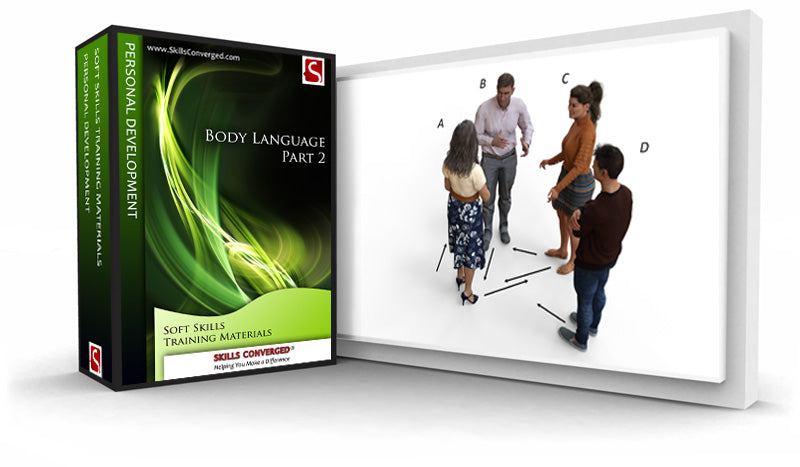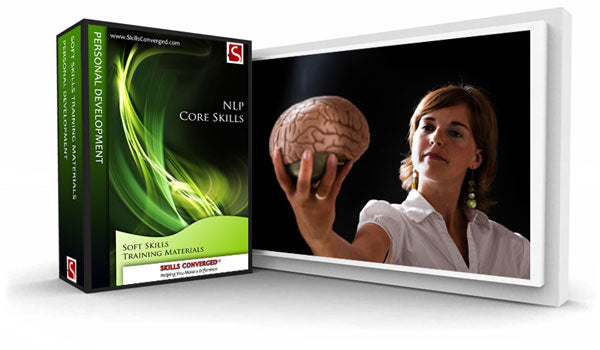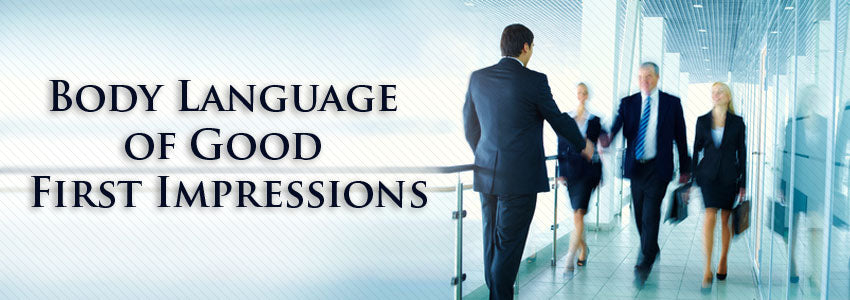
Body Language of Good First Impressions
Starting with a great impression when first introduced to someone can make the subsequent encounter a lot easier. In addition, when people don’t know anything about you, they will be eager to find out more about you so they can make a rough calculation on where you belong. Are you a serious prospect? What class of society do you belong to? Are you worth dealing with? Are you a friend or a foe? Are you rich or poor? Are you in to sell or are you in to buy? Would there be a short term or long term benefit in interacting with you?
Naturally, to accurately answer these questions, it takes a lot longer than a first impression. Nevertheless, we all aim to estimate an answer for all of these questions based on what we see and encounter within the first few minutes of seeing someone. This is carried out mainly with body language and non-verbal signals, along with the initial short greeting and possible small talk. The good news is that you are your own advertiser. You can plan this well ahead of the encounter. You can control exactly how you want to appear, what to say, how to express yourself by gestures and how to be seen. With so much competition in advertising and capturing people’s attention, getting the first impressions right is crucial.
Be Prepared for First Impressions
When going to meet someone for the first time, whether it is for business or pleasure, you must make sure that you appear at your best. The last thing you want is to be hurried, forget something or look unprepared. If you appear unprepared, the other person’s impression of you is that of a person who doesn’t really care about that encounter or about them. This is certainly not a good start. Your most important aim is to improve your first impression and to show the other person that you care about them and about their needs.
Let’s iterate over that again. First impression is not about you. It is about the impression the other person perceives about you. Hence, it is ultimately about them; it is about making them feel that you will be useful in their life and that you will solve some of their problems or improve an aspect of their lives. Otherwise people would have little incentive to interact with you at all.
Aiming for this critical goal, you can use the following body language guidelines:
- Dress appropriately and in a way that makes the other person comfortable when you are around
- Be on time so that the other person knows you are eager and care about his time
- Appear confident and resourceful so that the other person realises that he is dealing with someone worth his time
- Be relaxed and open so that you can in turn make the other person feel relaxed too.
Use Mental Visualisation
Before meeting an important person or going into a high-stakes meeting, visualise precisely how you will enter the room, go through the greeting sequence, explain why you are there and what you need from them while paying attention to your body language. Where do you stand and what would be your posture? How would you approach them? What would you say and in what tone? Where would be your arms? If invited to sit, where would you sit and how? If there are several people, who do you need to pay more attention to? How do you want to be seen? What impression do you want to leave behind? What would you want them to see as you leave the room? Are the back of your shoes clean? Is the back of your neck well groomed? Does your dress sit properly on your lower body? Does your overall body language match your intended message and goal?
Use Eye Contact to Improve First Impression
Eyes say a lot about a person. Lack of eye contact can be taken as disinterest, anxiety, weakness, submissiveness and generally would not contribute towards a good first impression.
Instead, just as you approach a person, make eye contact and adopt a facial expression that shows you are interested. Don’t maintain a neutral, I-am-only-doing-my-job expression. Often as soon as you show interest in the other person, they will show interest in you.

Look at the eyes, not the hands
Make a Note of a Person’s Eye Colour
Have you ever talked to a person and later wondered whether they wore glasses? What does this say about the amount of attention you have paid to them? It is likely you were so occupied with your own agenda, what you wanted to say and what you wanted to gain that your brain did not register a simple observation. As stated earlier, not showing interest and not caring for the other person is easily apparent to others.
To improve on this use the following simple trick especially when you first meet someone; make a note of their eye colour. This will force you to look at their eyes, pay attention to what you see and remain focused. The other person will read your gesture as an interest in them.

Aim to remember the colour of the eyes
Use Eyebrow Flash to Greet
The eyebrow flash is one of the most universal “hello” signals used throughout the world (except Japan which can be seen as sexual). This is raising the eyebrows for less than a second and then lowering them. The aim is to attract the attention of the other person by creating movement in the face. The eyebrow flash is usually returned with a smile and further interest by the other person. Absence of an eyebrow flash may indicate lack of interest or even a hostile attitude.
Deliver an Effective Handshake
One of the first interactions when meeting someone else is a handshake. This is particularly common in the business world with modern international standards of conduct which sometimes goes beyond cultural norms. The most ideal handshake is to mirror the handshake of the other person. As you saw, mirroring is a great way to establish rapport and make the other person feel comfortable with you.
Avoid the following types of handshake:
- Aggressive handshake. A strong hand shattering handshake will not leave a good impression. Even if you want to show that you are the man in charge, this is not the best way to do it as it leads to an immediate resentment.
- A double handed handshake. Popular with politicians, this is when the second hand is brought forward to make a handshake using both hands shaking one hand. If used with a stranger, it can alarm people to your sudden interest in them and they may go on guard from then on. Similarly, avoid other types of double-handed handshakes when one hand holds the other person’s wrist, upper arm or shoulder. This can be taken as an invasion of personal space and may not lead to a good start.
Follow these best practice guidelines when shaking hands:
- Be ready to shake hands. If you are carrying something, hold it in your left hand, so your right hand is free and ready. Don’t put your hands in your pocket or it can be taken as a sign that you don’t want to shake hands.
- Walk firmly and with confidence. The handshake starts with your approach. Stay erect while approaching the other person and take your time so you don’t appear hurried and eager, nor too slow and reluctant.
- Smile. Make a brief smile to show that you are interested. However, don’t overdo it as it can be interpreted as a sign of eagerness or manipulation.
- Make eye contact. It is critical to look at the person in the eye when shaking hands. A quick glance is enough to synchronise the handshake. Try not to be looking at the hands when shaking them. Aim for about 3 seconds of eye contact. For ladies, anything more than 5 seconds of eye contact with a person they have not met before can be interpreted as a sexual interest.
- Rise, if you are seated. If someone comes to shake hands with you and you remain seated, the first signal you have given them is indifference. This will not be a good start. The only exception not to rise is when you are eating or if you are a lady and in your culture it is normal or common to remain seated.
- Make a palm-to-palm handshake. Open palms suggests openness and honesty. If you don’t make a contact with your palm while shaking hands, the other person may take this as a sign of deception, as if you are hiding something. This is why we don’t like limp handshakes.
- Perform a straight up handshake. The best starting point is to show that you are both equal and no one dominates. Make sure your thumb is on top and your hand is straight as opposed to your palm facing slightly upwards or downwards.
State Their Name
When you meet someone, aim to state their name twice within the first 3 minutes of the communication. A person’s name is perhaps the most familiar sound in their world. It is also one of the first words they learn, so it is very special to people.
When you state a person’s name, it makes them feel important and worthy of interest. It helps you to remember the name by repetition and also shows that you are paying attention to them and that you care. Showing that you care is the first step in establishing rapport.
How to Remember a Name
If you use their name later on, people become very impressed by you since you have remembered them and gone through the trouble of learning their name. Many people don’t bother, so this is a great way to stand out from the crowd. Use the following five techniques to improve on your name learning:
- Remember. Make a habit to remember the name. If you don’t work on this habit, you are likely to greet a person without ever stating their name or making any effort in remembering it.
- Review. Ask for spelling or a repeat pronunciation. Make sure you get it right. If you are unsure of the pronunciation, you are likely not to use their name. It would be a lot more awkward to ask them later what their name was if you didn’t get it right the first time. Spend enough time right when they state it to make sure you understand it and pronounce it correctly. Your interest will show that you care.
- Repeat. Once stated, immediately repeat the name as suggested above within 3 minutes of a conversation. Aim to repeat more than once but don’t overdo it or you will appear like a desperate salesperson.
- Relate. Use associations to memorise the name. Relate the sound to something similar so you can easily associate the name with the person.
- Record. After your conversation, take a note of their name along with a quick summary of critical points in your encounter and your impression of the person. Don’t aim to keep everything in your head and worry about losing it. Use widely available IT tools such as smart phones to full extent to spread your memory beyond your brain capacity.
Don’t Play With Your Hair
This can be taken as a sign of stress along with any other fidgeting gestures. This body language trait is particularly applicable to women as they are more likely to do so due to longer length of their hair. Fidgeting can also be very distracting as people tend to pay more attention to moving objects.
Further Reading
Demarais, A., White, V. (2004) “First Impressions”, New York, NY: BanTam Books.
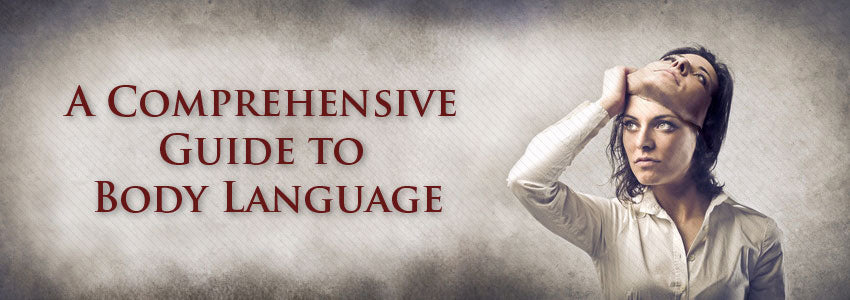
All Articles in the Series
A Comprehensive Guide to Body Language
Origins of Humans and Body Language
How to Read People Using Their Body Language
How to Influence Your Emotional State Using Body Language
Body Language Across Different Cultures
Body Language of Defensive Attitude
Body Language of Good First Impressions
How to Improve Personal Impact
Continue Reading the Body Language Series..
Body Language Guide Article IndexBody Language Training Materials
Body Language Exercises
Explore our collection of free body language training exercises and articles:



Use this body language exercise at the beginning of a session before covering non-verbal communication. The aim is to find out how much delegates already know about this topic and...
The aim of this exercise is to get the delegates think about body language and gestures and observe how such signals can be instrumental while communicating. The training exercise illustrates...
This is an exercise in communication with the aim to increase awareness of body language and non-verbal communications.





